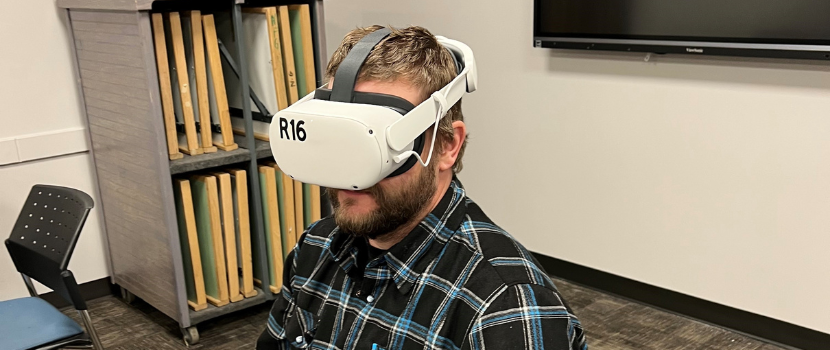
When Jeff Shular put on a virtual reality (VR) headset in Saskatoon’s plumbing classroom space for the first time, he was amazed with how it worked. The instructor is one of several teaching in the Joseph A. Remai School of Construction excited by virtual training models launching this fall that will allow Saskatchewan Polytechnic certificate and apprenticeship students to complete learning that otherwise might not be possible.
Stephen Pritchard, who oversees the construction trades on the academic side explains, “We have put considerable focus on technology enhanced learning, or TEL as it’s often referred to, in recent months. Our programs are working on some exciting initiatives that will make our training more accessible and also allow us to deliver more advanced training in expanding areas such as renewable energy.”
The VR headset Shular is helping to implement is part of a project to deliver virtual training to plumbing students. New curriculum added through trades education harmonization across Canada teaches maintenance of rooftop heating and air conditioning units. Finding the capital to work on such units in the real world is prohibitive, so an off-site training delivery model is essential. He explains that the headsets allow students to feel as if they are standing right in front of the heating or cooling unit. A VR glove allows the user to point and perform actions on the unit and safety is ensured because mistakes are virtual and can be easily corrected. “They are surprisingly easy to use,” says Shular. “I put one on and in five minutes I was able to start using it.”
Sask Polytech purchased 14 units to enable every student to have one to work on. The headsets are powered by a software system called Interplay, which delivers over 300 different training systems. Shular notes, “SAIT in Alberta currently uses this technology for this type of training and for other trades as well. We’re working with them to see where else we might be able to leverage it in our curriculum.”
The Construction Electrician apprenticeship program is also using new TEL systems to deliver specialized training. The program is replacing outdated motors and older electrical training units with high-tech Lab Volt modular trainers, which will give the instructors lots of options for various simulations. Program head Jay Vollet, who oversees electrician training at the Regina and Moose Jaw campuses, explains that the modules contain a data acquisition center that links them to a computer. “Modular trainers add variety and versatility to training because you can choose the module and the computer will then pull the data that you need to instruct on a specific skill.”
“These new trainers have a renewable energy component for wind and solar, which will be added to our apprenticeship programs to give us an easy way to do that training,” notes Pritchard. “These units are extremely versatile, giving us the opportunity to share training in remote settings, or to do standalone training. Vollet adds that instructors at Prince Albert campus are developing a micro-credential using the renewable energy components.
The school has also invested in programmable logic computer (PLC) trainers that will support apprenticeship students doing industrial automation training. These miniature standalone computing systems manage processes and allow for ongoing monitoring of electrical activity. “Our Prince Albert campus has a new lab that will teach students about these PLCs in a more hands-on way," says Greg Bell, program head for the electrician trades programs. “Older versions were plug and play. The new lab will be more realistic.” Sask Polytech plans to expand the initiative to all locations where they train pre-apprenticeship and apprentice electricians.
Subject areas that lend themselves to technology training tools are growing, explains Pritchard, who oversees training ranging from plumbing and pipefitting to construction electrical to refrigeration and air conditioning, among others. “Renewable energy is just one example. It’s going to be huge. With these new teaching tools, Sask Polytech is going to be able to support training our students in the next era of electronics.”
High-tech training equipment doesn’t come without a cost, but the programs see their value. “This kind of new teaching technology is fairly expensive,” says Pritchard, “but in a bigger way it’s really not. Projects such as the VR headsets and electrical simulators will cover a lot of training for a lot of students and apprentices over the coming decades. TEL isn’t something that is going to come and go. It’s going to be rooted in our programs.”
The Saskatchewan Apprenticeship and Trade Certification Commission (SATCC) administers the apprenticeship and trade certification system in Saskatchewan. Apprenticeship is a post-secondary education pathway in which 85 per cent of the learning happens on the job. The other 15 per cent happens in a classroom setting and is referred to as technical training. Institutions such as Saskatchewan Polytechnic are contracted by the SATCC to provide apprenticeship technical training across the province. Saskatchewan Polytechnic is the SATCC’s largest training provider.
For more information about programs in the Joseph A. Remai School of Construction, visit our website.

